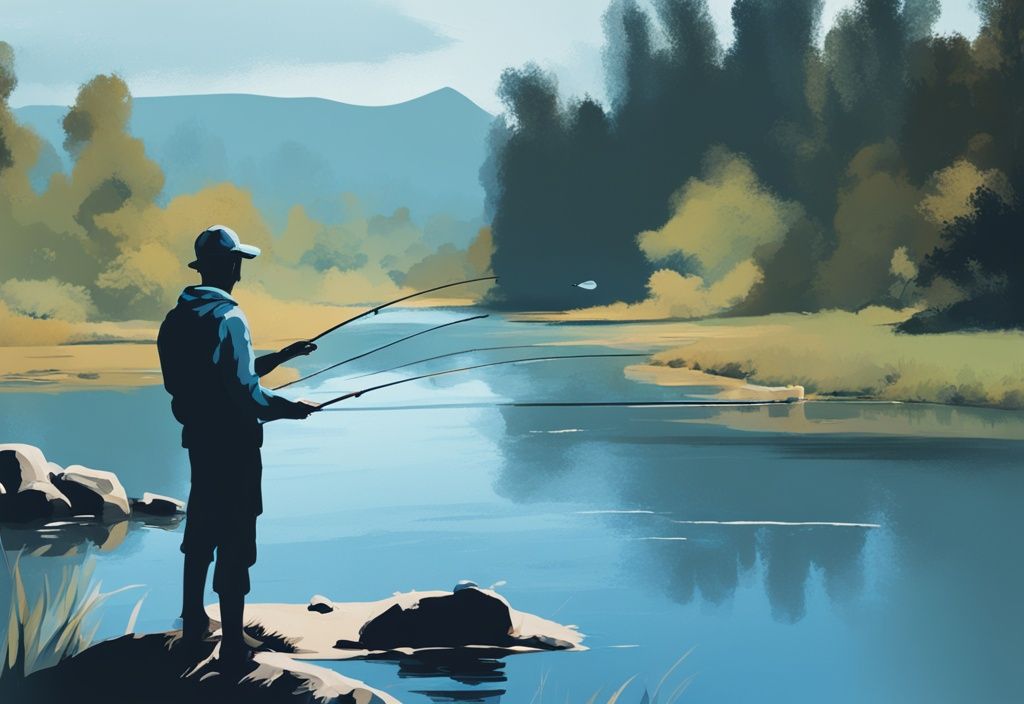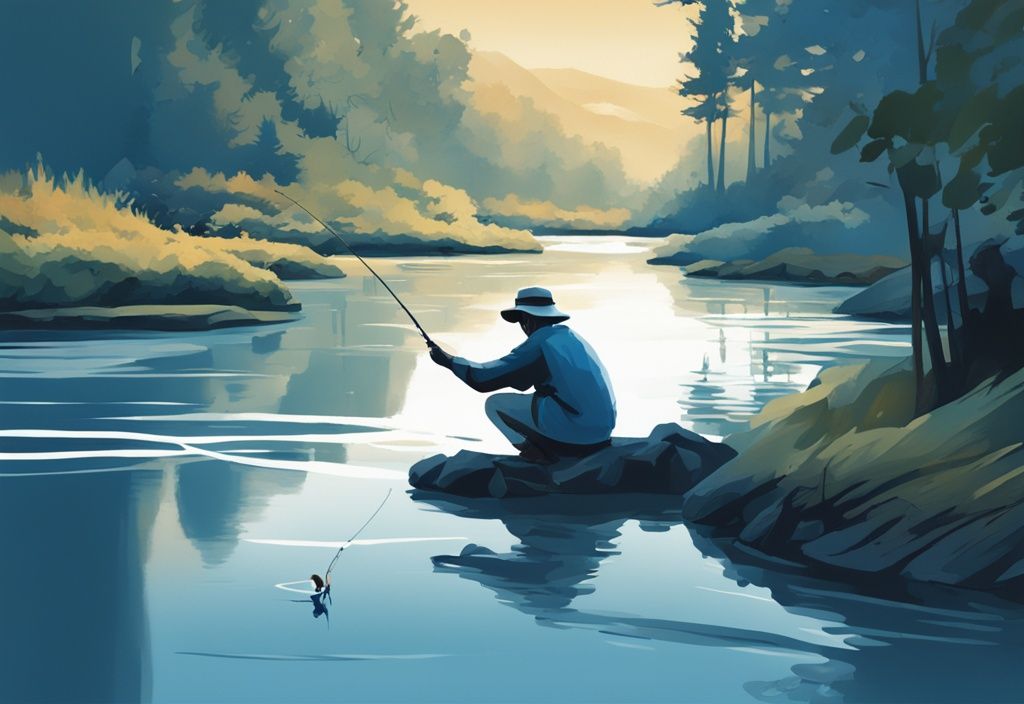Ever pondered over whether you should grab a fly rod or a spinning reel for your next fishing adventure? Well, as an angler with over two decades under my belt, I’ve juggled these choices and found joy in both. This guide is dedicated to helping you navigate the thrilling world of fly fishing and regular fishing.
The beauty of fly fishing lies in its artistry, its immersive experience that demands precision, while regular fishing offers accessibility, flexibility and shared fun. Each style holds its own charm and challenges, which I’ll explore in detail.
Expect to dive deep into each method, uncover their unique quirks and learn how they can redefine your fishing journey. So, will it be the grace of fly fishing or the versatility of the regular kind for your next trip? Let’s find out!
Introduction
There’s a world of difference between fly fishing and regular fishing, each offering its unique rewards and challenges. We’ll dive into what sets these two popular fishing methods apart, exploring everything from techniques to the experiences they provide. Ready to cast off? Let’s get started!
What is Fly Fishing?
Fly fishing, for those who aren’t yet acquainted, is an enchanting method that calls for the use of artificial flies as bait. These are crafted to mimic various insects, a delightful nod to the natural world. Unlike conventional fishing, fly fishing employs a uniquely weighted line to cast the feather-light fly, letting it land gracefully on the water.
It’s a pursuit that demands more than just technical skills; understanding the aquatic environment and fish behavior is crucial. Picture this: standing knee-deep in a crystal-clear stream, your senses fully attuned to nature around you. The allure of fly fishing is the intricate dance between angler and water, making every catch a testament to patience and precision. It’s not just a pastime but a refined hobby that blends nature, skill, and craftsmanship.
Understanding Regular Fishing
Regular fishing, or spin fishing, often seems to be the go-to for many. This method typically involves live bait or artificial lures, equipped with a weighted sinker that helps in casting and enticing the fish. Imagine a sunny afternoon spent lakeside, casting your line with friends and family. It’s a social activity at heart, perfect for group outings where the focus is more on quantity than the intricacies of technique.
Spin fishing is a fantastic gateway for beginners due to its accessibility and straightforward approach. Bells and whistles are minimal here—just simple, quick casts, and often a mixed bag of fish species at the end of the day. It’s about enjoyment, relaxation, and the thrill of that initial tug on your line.
Conclusion
By offering a clear contrast between fly fishing vs regular fishing, these introductory insights set the stage for a deeper dive into the nuances of each style. Whether you’re drawn to the skillful, immersive experience of fly fishing or the straightforward, social joy of regular fishing, both promise a unique adventure for every angler out there.
Stay tuned as we delve deeper into the specifics, comparing techniques, gear, and the unique preferences that make fly fishing and regular fishing beloved pastimes. Whether you’re a seasoned pro or new to the sport, there’s always something new to learn and enjoy in the world of fishing.
Differences in Fishing Techniques
As anglers, we’re always curious about what sets various fishing styles apart. Understanding the nuances between fly fishing and regular fishing can deepen your appreciation for both methods.
Fly Fishing Approach
Fly fishing, my friends, is an art form. Picture this: You’re standing knee-deep in a crystal-clear stream, with a landscape so serene it feels like time might just pause. The heart of fly fishing lies in using delicate, artificial flies that mimic the exact insects trout feast on. Mastering this requires a keen eye for detail and, oh, the casting—the beautiful, rhythmic dance of the line through the air. You must become one with the water, understand its inhabitants, know when the mayflies hatch or the caddisflies emerge.
Every flick of the wrist, every cast you make, it’s like performing a choreographed sequence. It’s less about luck and more an intimate knowledge of the ecosystem. Imagine the satisfaction of fooling a fish into thinking your lure is its next meal. It’s a blend of science, art, and a dash of poetry, evolving you as a part of this aquatic ballet.
Regular Fishing Tricks
Now, let’s talk about regular fishing, often known as spin fishing. You might be picturing a relaxed, sunny afternoon by the lake, casting your line with just a flick of your wrist—you’re spot on. Regular fishing champions simplicity and accessibility. It focuses on the sheer joy of catching fish without the steep learning curve of mastering insect life cycles.
You’ve got lures that resemble baitfish—flashy, attention-grabbing little things designed to tempt fish with their shiny exteriors. No need to delve into the complex details of local marine life. Just cast, reel in, and enjoy the ride. If you’re curious about different fishing techniques, you might want to explore what is Asian fishing for a unique perspective. It’s straightforward, fast, and perfect for those days when you just want a leisurely time by the water. Plus, it’s super social; perfect for sharing stories and laughs with friends.
In the context of fly fishing vs regular fishing, both methods offer distinctive experiences. Fly fishing enthralls you with its depth and skill, fostering a profound connection with nature. On the flip side, regular fishing is all about ease and enjoyment, making it a fantastic choice for laid-back outings. Whichever you choose, you’re bound to find your own piece of joy and adventure in the water.
Understanding Equipment
In the world of fishing, your gear can make all the difference. Whether you’re comparing fly fishing vs regular fishing, the tools of the trade are uniquely tailored to each style, setting the stage for different experiences on the water.
Essential Fly Fishing Gear
When diving into fly fishing vs regular fishing, the first thing you’ll notice is the distinct equipment. Fly fishing leans on specialized gear to mimic natural feeding habits of fish like trout and salmon. The cornerstone of this setup is the fly rod. Unlike the more rigid spin rod, a fly rod offers flexibility and finesse for the delicate dance of casting lightweight flies. This flexibility grants the precision needed for a picture-perfect cast, a skill every fly angler cherishes.
Next up is the weighted line, essential for sending your fly exactly where you want it. Contrary to typical fishing lines, fly fishing lines carry the weight themselves, giving those feathery flies the needed push. Attached to this line is a tapered leader, which tapers down in diameter from the line to the fly. This design presents your fly naturally, giving you a better shot at fooling those wily fish.
And let’s talk about flies that imitate insects. These tiny marvels are crafted to mimic various insect stages, a detail that taps into the fish’s instincts. Perfecting the use of these elements makes fly fishing not just a technique but an art, turning each session into a rewarding adventure.
Tools for Regular Fishing
On the flip side, regular fishing brings its own set of tools designed for versatility and ease. The spin rod, more rigid than a fly rod, is built to handle heftier lures and endure the tug of larger fish. This robustness means you can cast with minimal effort, making it perfect for newbies and seasoned pros alike.

The magic in regular fishing often lies in the weighted lure. These lures mimic baitfish with eye-catching colors and movement, capturing the fish’s attention effectively. Central to this setup is the spinning reel, a device that aids in casting and retrieval, ensuring smooth and controlled line handling. Whether aiming for distance or precision, the reel is your best friend.
As for the fishing line, variety is the spice of life. Monofilament and braid lines offer distinct benefits. Monofilament provides stretch and flexibility, an excellent choice for clear waters and subtle presentations. Meanwhile, braid lines bring strength and sensitivity to the table, ideal for dense cover and deeper waters. Knowing when to use which line enhances your ability to adapt to different fishing environments, boosting your chances of success.
Analysis: Fly Fishing vs Regular Fishing
When it comes to angling, the age-old debate of fly fishing versus regular fishing often sparks lively discussions. Each style has its own unique charm and set of advantages, catering to different types of anglers and scenarios. Understanding the nuances of both can help you decide which method suits your next fishing adventure.
Instances where Fly Fishing is Preferred
Fly fishing shines in specific environments and scenarios. Picture this: a serene river, the sound of water rushing over rocks, and fish darting beneath the surface. That’s where fly fishing truly comes alive. It’s particularly effective in rivers, streams, and still waters teeming with trout and salmon. These aquatic havens allow anglers to deploy the unique techniques of fly fishing to their fullest potential, artfully mimicking the insects that trout naturally feast on.
The method isn’t just about catching fish; it immerses you in nature. It’s an engaging dance that requires a deep, academic understanding of water ecosystems. Imagine spending your early mornings studying insect life and water currents, adding an intellectual layer to your hobby. Fly fishers often appreciate this blend of physical and mental engagement, finding joy in mastering complex, skillful techniques. This precision and finesse demanded by fly fishing can make it a deeply rewarding and almost meditative experience.
Situations Suited for Regular Fishing
Now, let’s talk about regular fishing, or as some of us like to call it, spin fishing. This method is the jack-of-all-trades, versatile enough for various environments like oceans, lakes, and ponds. The beauty of regular fishing lies in its ability to target a broader spectrum of fish species. Whether you’re after bass, pike, or even the elusive marlin, regular fishing has you covered.
One of its major perks is convenience. Imagine you’re on a weekend getaway with family and friends, and you want to toss a line in the water without much fuss. Regular fishing gear makes this possible with its easy-to-use equipment and quick setup. The speed and efficiency of catching fish make it appealing for those who want fast results. Plus, it’s a fantastic fit for social settings—think casual outings or community fishing events. Even beginners can find success without needing extensive preparation or deep knowledge of the aquatic ecosystem, thanks to the straightforward approach of regular fishing.
Regular fishing is all about accessibility and enjoyment. It welcomes everyone, from seasoned pros to first-time anglers, making it a universally beloved activity.
Cost Comparison: Fly Fishing vs Regular Fishing
The debate on the costs associated with fly fishing vs. regular fishing reveals some interesting insights, especially when considering the initial investment and ongoing expenses for both these popular fishing styles.
When it comes to fly fishing, anglers often face a higher initial investment. The specialized equipment needed for fly fishing, such as fly rods, weighted lines, tapered leaders, and imitation flies, tends to be pricier compared to regular fishing gear. In the UK, anglers often spend over £400 annually on fly fishing tackle alone, with additional club fees amounting to roughly £110 each year. This investment reflects the premium quality and tailored design of fly fishing gear intended to create a natural and precise imitation of insects that many fish species, particularly trout and salmon, feed on.
On the other hand, regular fishing, also known as spin fishing, while often perceived as less expensive initially, can still add up in costs over time. Spin rods, spinning reels, and weighted lures needed for spin fishing vary widely in price, but high-quality gear can approach the cost of fly fishing equipment. The gap between the cost of top-tier fly fishing gear and regular fishing gear narrows significantly when considering premium and specialized spin fishing equipment.
Moreover, spin fishing lures and bait require regular replenishment, leading to consistent, albeit smaller, ongoing expenses.
Despite these cost variations, both fishing styles necessitate a financial investment that aligns with the angler’s commitment level and fishing goals. The choice between fly fishing vs regular fishing often boils down to personal preference, desired fishing experience, and willingness to invest in quality gear tailored to each method.

Ultimately, while fly fishing gear tends to be more expensive upfront, the allure lies in the specialized, high-quality equipment essential for mastering this intricate sport.
Conversely, regular fishing offers a balance of affordability and accessibility, with costs that can rise depending on the quality of the gear selected. Both methods, however, offer distinct and rewarding experiences that make the investment worthwhile for dedicated anglers.
Fishing Locations
Popular Fly Fishing Spots
Fly fishing vs regular fishing often finds its distinction in the natural settings. Fly fishing enthusiasts cherish rivers and streams where trout flourish, creating not just a fishing trip, but an immersive experience. Imagine standing knee-deep in a river with only the sounds of nature around you – that’s the magic of fly fishing. These settings are often remote and breathtaking, offering angling amidst spectacular landscapes.
Take Montana’s Madison River, for instance. It’s famed for its trout density and awe-inspiring views, earning it a top spot among fly fishers. Or consider the River Test in the UK, with its crystal-clear waters and dynamic insect life. These elements combine, offering ample opportunities for skillful casting and a close connection with the aquatic environment that’s truly unique to fly fishing.
Best Locations for Regular Fishing
When it comes to fly fishing vs regular fishing, regular fishing stands out for its sheer versatility. Regular fishing can be enjoyed just about anywhere – from ocean beaches to piers, lakes, and even local ponds. This variety offers anglers a broad range of environments and fish species to chase.
The Florida Keys, for example, are a haven for ocean fishing enthusiasts, filled with a vibrant community and rich marine life. Think of the thrill of catching your first tarpon amidst stunning ocean views. Likewise, the Great Lakes present fantastic opportunities for freshwater fishing, yielding everything from perch to salmon. And don’t overlook local ponds, often tucked into urban or suburban settings. They’re perfect for quick, casual fishing trips, making it easy to reel in a relaxing, social experience. Regular fishing’s accessibility and variety make it a winner in its own right.
Learning Curve: Fly Fishing vs Regular Fishing
Fly Fishing: Mastering Patience and Precision
Imagine standing knee-deep in a crystal-clear stream, the sound of water burbling around you. Fly fishing is an advanced angling method that demands greater patience and a solid grasp of aquatic insect life and water characteristics. The technique focuses on delicate, precise casting, often mimicking the natural motion of insects to entice fish. This isn’t just fishing; it’s a dance of finesse that requires you to immerse yourself in the local ecosystems profoundly.
Mastery of fly fishing doesn’t come easy. You need to understand which insects are hatching and how fish behave. But let me tell you, the reward is immense. Each successful cast feels like poetry in motion, and every catch brings a satisfying sense of accomplishment. If you’re someone who loves a challenge and seeks a deeper connection to nature, fly fishing offers an unforgettable, immersive experience.
Spin Fishing: Accessibility and Simplicity
In contrast, spin fishing, or what most might refer to as regular fishing, is the bread and butter of the angling world. It’s more accessible and beginner-friendly. Picture yourself on the banks of a serene lake, casting your line with a simple flick of the wrist. There’s no intricate technique required here—just you, your rod, and the water.
Spin fishing doesn’t demand you decode the mysteries of aquatic insect life or water features. It’s straightforward and perfect for casual outings where the main aim is to relax and catch some fish. You can quickly get the hang of it, making it an excellent choice for spontaneous fishing trips and those who’d rather enjoy the moments rather than the complexities of angling. If ease and convenience are your priorities, spin fishing is versatile enough to adapt to various fishing environments and provide immediate rewards.
Fly Fishing: An Academic Pursuit with High Rewards
For those who relish a good intellectual challenge, fly fishing is an academic pursuit that pays off in spades. You’ll dive deep into the science of entomology, getting to know the aquatic insects that fish feast on. Armed with a flexible rod and a specially designed weighted line, you’ll be casting delicate, lightweight flies that mimic natural insect movements.
Sure, the initial learning curve can be steep, but every aspect you master adds another layer to your skill set. And when you finally get that perfect cast, the sense of accomplishment is unparalleled. This isn’t just a hobby; it’s a passion that enhances your appreciation for natural water ecosystems. You’ll find yourself not just improving as an angler but also as a steward of the environment.
Spin Fishing: Straightforward and Versatile
Spin fishing’s appeal lies in its straightforwardness. It’s like an all-access pass to the world of fishing, perfect for those impromptu trips or lazy afternoons. There’s little to no preparation needed—just grab your gear and go. Whether you’re in freshwater or saltwater, spin fishing’s versatility means you can target a wide range of fish species with minimal hassle.
The equipment? Easy to handle. The technique? Just a flick of the wrist. It’s this simplicity that makes spin fishing so inviting. Family outings, solo trips, or a day with friends—spin fishing is accessible to nearly everyone, ensuring that regardless of experience level, you can enjoy the thrill of a catch. Whether you’re a novice or a seasoned pro, the straightforward nature of spin fishing guarantees you won’t miss out on the magic of the moment.
Pros and Cons of Each Style
Fly fishing and regular fishing each bring their own set of perks and challenges to the table. Whether you’re a newbie or a seasoned angler, understanding these differences can help you decide which style suits you best.
Advantages and Disadvantages of Fly Fishing
Fly fishing is like a dance with nature, requiring finesse and patience. One of the standout perks is the intimate connection it offers with water ecosystems. By using artificial flies to mirror the natural diet of trout, you’re not just fishing; you’re engaging in a scholarly pursuit, practically immersing yourself in the aquatic world.
Imagine casting your fly into a pristine, narrow stream where regular fishing can’t reach. The reward of catching a hefty trout in these secluded spots is immense. Yet, there’s a catch (pun intended): the learning curve is steep. The art of casting can be quite the challenge for beginners, often leading to bouts of frustration.
Expect to shell out a decent sum for gear—a fly rod, weighted line, and a selection of artificial flies aren’t cheap. Also, successful fly fishing demands a thorough understanding of local insect life and water conditions, making it a time-consuming affair. Despite these hurdles, the gratification of mastering fly fishing is unparalleled.
Pros and Cons of Regular Fishing
Regular fishing, often called spin fishing, is the jack-of-all-trades in the fishing world. It’s incredibly accessible, making it a great starting point for beginners. Whether you’re casting in freshwater or saltwater, this method lets you target a broad variety of fish species with ease.
Picture yourself on a sunny day, casting a heavier lure to catch a big one. Spin fishing doesn’t require you to be an insect expert, allowing for quicker, more productive sessions. However, using heavier lures can sometimes scare away fish, especially in heavily fished areas.

While the initial investment in regular fishing gear is relatively low, splurging on high-quality equipment can quickly bridge the cost gap between fly fishing and spin fishing. One downside is the potential for a more superficial understanding of the aquatic environment, which could make you complacent over time. Even with these drawbacks, regular fishing remains a straightforward and highly rewarding venture for newcomers and seasoned anglers alike.
Safety Measures for Both Fishing Styles
When it comes to ensuring a safe and enjoyable fishing experience, both fly fishing and regular fishing (like spin fishing) demand their own tailored precautions. By understanding and preparing for these unique challenges, you can focus more on the thrill of the catch and less on the perils of the environment.
Fly Fishing
Fly fishing is a splendid mix of skill, patience, and Mother Nature’s unpredictable beauty. However, wading through fast-moving rivers can pose a real threat. Trust me, I’ve faced many a swift current that tried to sweep me off my feet. Here are some tips to keep you steady:
- Reliable Waders: Not just any waders, but ones that fit well and provide good buoyancy. You’ll stay dry and maintain your grip on those slippery river stones.
- Water Assessment: Always give a good spot-check to the water. Flow speed and depth are your first indicators of whether it’s safe to wade in. Sudden changes in water levels can be a red flag, so keep your eyes peeled.
- Balance: Constantly work on your balance. Practice makes perfect, and in this case, it might also save you from a dunking.
Fly fishing’s all about respecting the river and the rhythms of nature. Stay aware, stay dry, and the river’s magic will do the rest.
Spin Fishing
Spin fishing offers a world of variety, from tranquil lakes to bustling ocean shores. Each setting has its own set of risks and rewards. Let’s dive into some key safety tips:
- Casting Control: The beauty of spin fishing is in the casting. But, a heavy lure can turn into a spear if you’re not careful. Always practice your casting technique. Have you ever had a hook snag your favorite shirt? Not fun. Double-check your surroundings and ensure there’s no one in your hook’s path.
- Survey the Area: Before you even cast, take a good look at where you’re fishing. Hidden rocks, tree branches lurking under the surface, and sudden drops can spell trouble. Scouting safe, hazard-free spots not only protects you but keeps your gear intact too.
Ultimately, vigilance is key. With the right precautions, spin fishing turns into a relaxing and exhilarating experience.
By being conscious of these safety measures, both fly fishing and regular fishing can be far less about accidents and far more about those memorable moments on the water. So gear up, be prepared, and let the adventure begin!
FAQ
Why Choose Fly Fishing Over Regular Fishing?
Imagine this: the cool rush of a mountain stream, the delicate dance of a fly on the water’s surface. Fly fishing offers a deeply immersive and academic experience that connects you intimately with nature. It rewards your skill and patience, and it’s perfect for those moments when you’re targeting specific species like trout and salmon. It’s not just about catching fish; it’s about mastering the art.
Which is Ideal for Beginners?
Let’s be honest, regular (spin) fishing is much easier to pick up and more accessible. You can grab a rod, learn a few basics, and you’re off to the races. Fly fishing, though, offers a whole different level of satisfaction once you get the hang of it. Sure, it has a steeper learning curve, but that makes mastering it all the more rewarding. Trust me, I’ve seen countless beginners blossom into confident fly anglers.
Why is Fly Fishing More Challenging?
Fly fishing isn’t just about casting a line; it’s about artistry and precision. You need skillful casting technique and a deep understanding of aquatic insects and their habitats. That’s what makes it so challenging and fascinating. It’s like solving a beautiful, ever-changing puzzle where each piece requires your utmost attention and finesse.
Is Fly Fishing Limited to Certain Water Types?
Fly fishing truly shines in rivers, streams, and still waters. Think of those picturesque trout streams or serene mountain lakes. However, it’s less effective in oceans or deeper lakes compared to spin fishing. The environment plays a huge role, and different waters present unique challenges and opportunities.
Final Thoughts: Choosing Between Fly Fishing and Regular Fishing
Making a decision between fly fishing and regular fishing comes down to personal preference and what you seek from the fishing experience. Each style offers unique benefits and drawbacks, catering to different types of anglers and fishing goals.
Fly fishing is often cherished for its immersive and academic nature. This technique involves more than just catching fish; it is about mastering the skill of casting, understanding aquatic insect life, and developing an intimate connection with nature. The challenge of replicating the natural diet of trout and the joy of successfully landing a fish after meticulous preparation are deeply rewarding for many anglers. However, the learning curve can be steep, and the initial investment in gear can be significant. Fly fishing is usually better suited for those who enjoy the process and are eager to immerse themselves in the intricacies of the sport.
On the other hand, regular (spin) fishing tends to be more straightforward and accessible, making it an excellent choice for beginners or those who prefer a less demanding approach. With spin fishing, you can quickly get started with minimal knowledge and equipment. It is well-suited for a variety of environments, from freshwater lakes to ocean beaches, allowing enthusiasts to catch a diverse range of fish species. This method is particularly appealing in social settings, often being a staple for family outings or group activities.
Regardless of which style you lean towards, both fly fishing and regular fishing provide enjoyable and fulfilling experiences. There’s no wrong choice—only different ways to derive joy from the sport. It is highly recommended to try both methods to determine which aligns best with your personal preferences and fishing aspirations.
Ultimately, what matters most is the personal enjoyment and fulfillment you gain from the experience, which is enhanced when you practice sustainable fishing methods that ensure the preservation of aquatic environments for future generations. For more information on sustainable fishing practices, check out this resource from National Geographic: sustainable fishing. By experimenting with both styles, you’ll be able to find the one that best meets your needs and enhances your connection to the sport.


